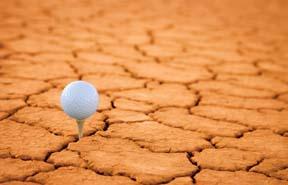The drought that overwhelmed much of the central United States the past two summers might be making an encore. That's bad news for golf courses that have yet to rebound from the dry conditions they faced in 2011 and 2012.
"For a lot of guys, their wells are not back up yet, and their holding ponds are not back to full capacity," said Andy Morris, superintendent at the Country Club of Peoria in central Illinois.
"If we're struggling before we even hit the stress period, well, if you just sneeze out there on the golf course you're going to open it up to all kinds of disease pressure."
 The bad news for turf managers came on Valentine's Day from a panel of experts speaking to the U.S. Senate committee on agriculture, nutrition and forestry.
The bad news for turf managers came on Valentine's Day from a panel of experts speaking to the U.S. Senate committee on agriculture, nutrition and forestry."The continuing conditions really look like they're setting up for a very similar level of drought in the Midwest and West," Roger Pulwarty of the National Oceanic and Atmospheric Administration told the committee.
Drought of historic levels the past two years has decimated agricultural output throughout the Midwest and was equally damaging to golf courses throughout the nation's heartland. The NOAA called it the worst drought since the 1930s Dust Bowl.
Water-use restrictions for golf courses were common throughout the Midwest last summer, and some courses in parts of Illinois had their water turned off completely with predictable results.
Morris is fortunate that he is able to buy potable water from the city of Peoria Heights, but even he is waiting for the day that his supply is turned off. He had to cut usage last year by 25 percent because the city couldn't pump water from wells to holding tanks quickly enough to meet demand during the driest part of the summer. He had blown his water budget for the year by June. Typically, he has enough money in the coffer to buy water through September, and sometimes into October. Last year, the club had to spend more to get the course through the summer with live turf.
"If you have to do that one year, the club looks at it as just one of those things," Morris said. "But if you have to do it a second year, or maybe a third, it puts a lot of pressure on the club and the superintendent.
"I tell people I love my job, but the past two years I haven't liked it very much. The stress of getting through the summer has been exhausting."
Farther north in the Chicago area, some superintendents already are preparing for another hot, dry summer. Billy Casper Golf, which manages dozens of courses throughout the country, including more than 20 in the Chicago area, regularly conducts educational seminars for its superintendents. One scheduled next month for the country's Midwestern superintendents will focus on helping attendees get the most from existing irrigation systems so they can manage water more efficiently.
Rationing water to keep turf alive in September was common throughout the Chicago area, said Bryan Stromme, Midwest regional director of agronomy with Billy Casper Golf.
"You'd water to keep it alive, not lush green," Stromme said. "It was dormant turf, but it was alive."
Many of the courses in the Chicago Park District have older irrigation systems, including single-row designs. That meant dragging hoses throughout the summer, Stromme said.
Like their cousins downstate, many courses in Chicago are beginning the season at a disadvantage. Water levels in ponds and wells still are down, and weakened turf throughout much of 2012 means many facilities will have little margin for error this year. Getting off to a strong start will mean tweaking agronomic practices before the season begins, which last year in Chicago came six weeks earlier than the historic average.
"We're going to make sure everyone (in the Chicago Park District) has the right fertility, and we'll be using a lot of wetting agents," Stromme said. "I'm fortunate to have a solid team of superintendents who all have worked hard to build solid agronomic programs."

